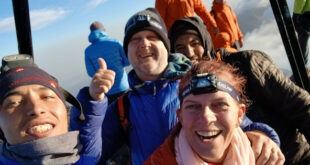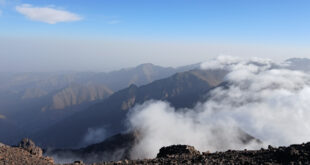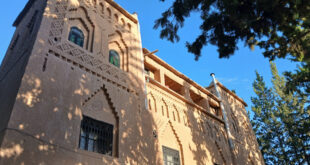I am in heaven as I sit on our balcony draped in a blanket watching the rugged shoreline of the Tongass Narrows slowly pass by. Verdant rainforest nestles beneath snow-capped hillsides and waterfalls tumble towards shimmering waters. Tiny islands, clad in pristine shrubbery, dot the narrows and we eagerly scan the water for wildlife. Suddenly, a spray of water off the side of the ship. A hulking whale slowly breaches the surface. It commences a mesmerising dance of diving and surfacing accompanied by spurts of water. Another whale appears and in tandem they descend and rise like a slow-moving roller coaster. Shortly afterwards, more water disturbance as a small pod of dolphins appears. They glide playfully through the wake of our ship as we pass a buoy laden with sea lions basking in the sun. We watch entranced as the colourful boardwalk of Ketchikan grows nearer. The approach to Ketchikan is so captivating and beautiful, it is hard to believe that Alaskan state officials once dubbed Ketchikan the wickedest city in America. Despite a history of notoriety, fuelled by boozy brothels and salmon wars, here are 6 epic reasons to make the effort to visit the wickedest city in America.
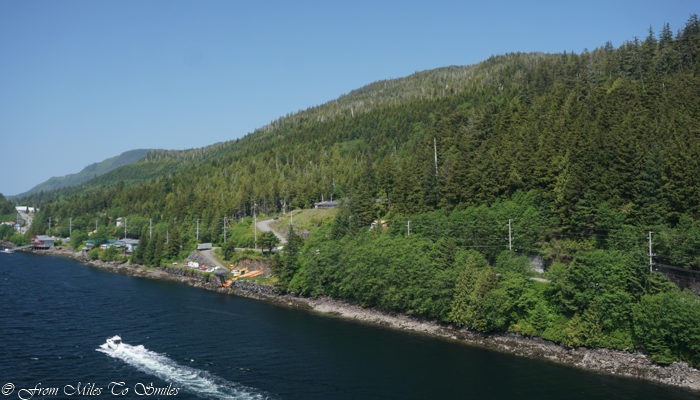
6 reasons to visit the wickedest city in America
1. Wildlife
You have guessed it. One of the primary reasons to visit Ketchikan is the plethora of wildlife in this remote paradise. Alaska is a giant playground for a multitude of species. After all, the State is huge! It is the largest State in the United States and is 2.5 times the size of Texas and over 4 times the size of both California and Montana. Yet, despite all this land mass, Alaska has a population of just over 700,000 people. Texas, by comparison, has a population of 29 million and California has over 39 million. Pretty empty right?
This untouched wilderness of forest, glaciers, mountains and untarnished coastline is like honey to a bee for many animals. They have space to roam without human encroachment. Historian, Harry Ritter, sums Alaska up perfectly. It is ‘like nowhere else – wild, extreme and amazing.’ I could not agree more and it seems the abundant wildlife concurs.
If you love stats, and want to read more comparisons of Alaska and other States, check out this post by Royal Alaskan Movers. In the meantime let’s take a look at some of the wildlife you may encounter in the wickedest city in America.
Bears
According to the Alaska Department of Fish and Game, there are a whopping 100,000 black bears in Alaska. There are a further 30,000 brown/grizzly bears. Let’s put that into context. In Alaska, for every 5 people, somewhere a bear is lurking! Fortunately, this epic landscape has abundant food for bears. They feed on berries, flowers, grasses, herbs and fish amongst other things. Phew, those 5 humans should be safe for now!
By the way, if you are unaccustomed to the possibility of daily bear encounters, you may wish to read ‘how to protect yourself against bears and other beasts.’ Inspired by our own experiences in the wilderness, this post provides guidance on what to do if you do bump into a bear or other dangerous animals!
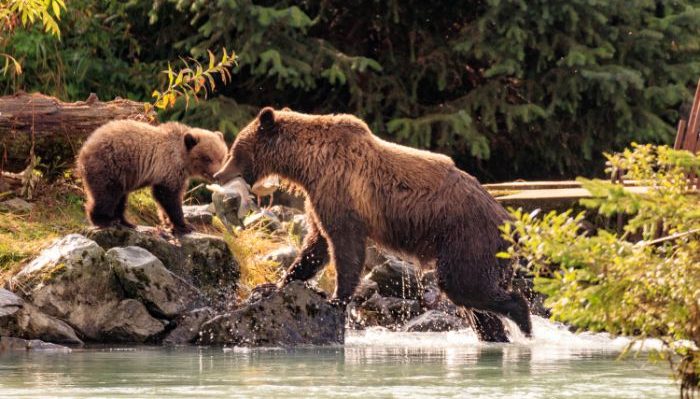
But Alaska has so much more to offer than just bears. Wildlife lovers are in for a treat!
Whales
Unpolluted icy waters, untouched by mass civilisation, are the perfect habitat for many whale species including orcas, beluga, humpback, minke and sperm whales. Alaska’s whales travel thousands of miles from warmer waters in Hawaii, California and Mexico. They make this epic journey annually to feed on abundant sea life before returning south to breed.
During our Alaskan cruise we see whales virtually every day. From sea and shore, we regularly spot the telltale plumes of spray as they emerge from the depths. Just one of the highlights of our cruise but you don’t need to cruise to experience these amazing scenes.
If you would like to learn more about whales in Alaska, check out the Alaska Collection.
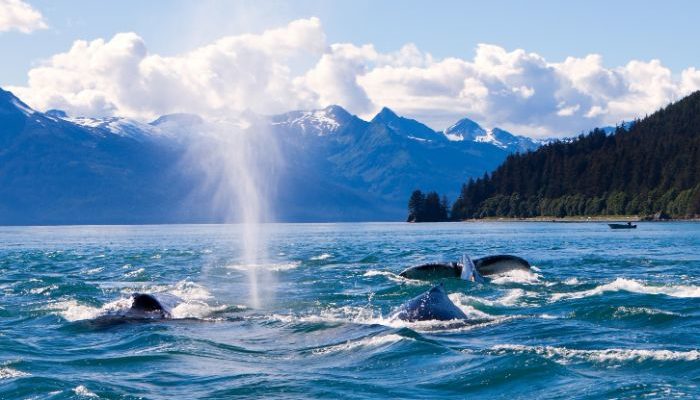
Salmon run
Ok, I accept that most people do not get excited about the prospect of salmon. However, Ketchikan is the salmon capital of the world and visitors in summer can witness the amazing annual salmon run. It is incredible to witness huge congregations of salmon work themselves to near exhaustion as they valiantly swim upstream on a quest to reproduce. Even more so when you discover that they die after spawning. Isn’t that the ultimate sacrifice? Astonishingly, after 2 to 8 years of living in saltwater, they return to the source of their birth, following scents they memorized as young hatchlings.
Salmon reproduction
Once they return to their birthplace, they create depressions, known as redds, in the riverbed. The female lays a mountain of eggs (between 2,500 and 7,000) in these redds before the male fertilises them. Now, that is what I call efficient baby making! After this monumental feat, most salmon die within days or week, leaving behind a colossal legacy of baby salmon. In some ways this cruel reality seems appropriate for the wickedest city in America.
Of course, the other added advantage of the salmon run is that the possibility of a gluttonous fish banquet lures bears and birds eager to gorge. Fishermen also flock to the area hoping to make the catch of a lifetime.
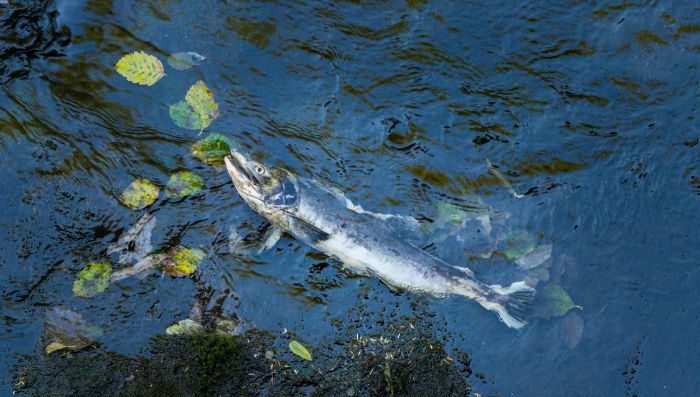
Incredible Alaska fishing statistics
Ketchikans talk in awe of salmon and fishing in general. It is no surprise given Alaska produces more seafood than any other US state. It accounts for 43% of pollock, 11% of salmon and 6% of crab exports globally (Source: Anchorage Daily News). That is pretty damn impressive for such a small population. Those fishermen must be nearly as exhausted as the salmon (although thankfully they do not die after spawning!)
Further reading
If you would like to increase your salmon knowledge further, check out this 66 page update from the Alaska government. Or, if you are now intrigued with the life cycle of salmon, this post from Sciencing.com is a pretty fascinating read!
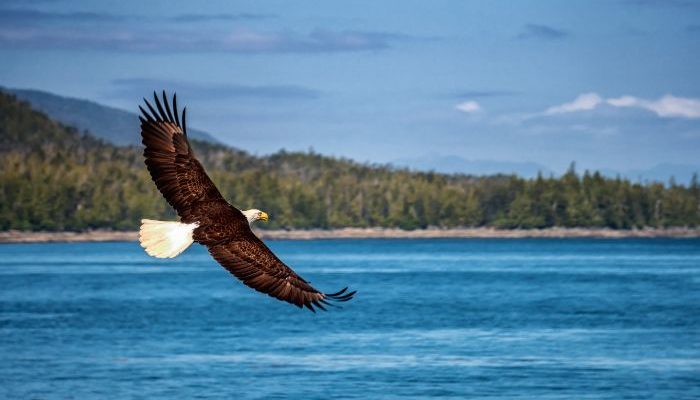
Birds of prey
Now I am not going to lie, I rarely get excited about bird sightings. Parrots maybe, due to their stunning colours and loud squawking, but most birds pass me by. Don’t hate me bird watchers!
In Alaska however, we see countless bald eagles and I grow to love their grace, precision and ruthlessness. On a boat in George Inlet, we watch as two eagles swoop and dive, jostling to steal the fish that our fisherman throws into the air. The display is incredible and we watch mesmerised as they launch from their nests high in the trees above the shoreline. Even from hundreds of feet away, the scent of the fish is enough for them to rocket towards the water at breakneck speed. They pounce mercilessly and steal their pray, just a few feet above our heads, before gracefully retreating to feast. Now that is a show I will not forget in a hurry!
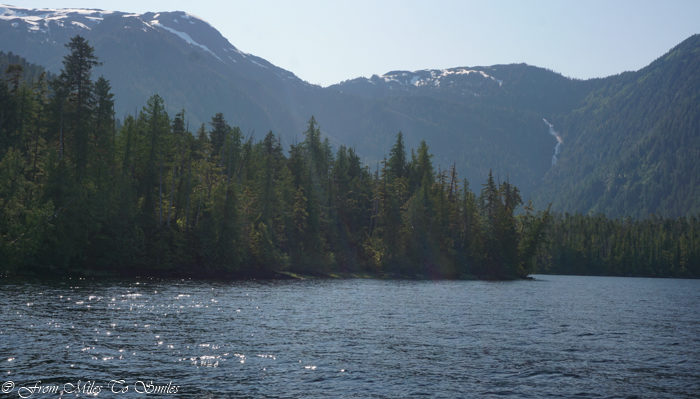
Other wildlife
Alaska is such a State of superlatives that the list of wildlife you can see is pretty damn long. Check out the full variety of wildlife on Alaska Fish and Game site. As you can see, it includes dolphins, seal lions, seals, and a ton of other animals. If you love wildlife, Alaska and Ketchikan should be bumped to the top of your bucket list now.
2. Seafood and shellfish feasts
By now, you are clearly all experts in the Alaskan fishing industry. It will probably not surprise you therefore to discover that another highlight of Ketchikan is succulent, juicy seafood. As the largest seafood producer in the entire United States, the waters around Ketchikan team with salmon and a wide variety of other fish. However, Alaska also accounts for two-thirds of all shellfish production in the United States and the surrounding waters are home to copious Dungeness crab. A trip out into the inlet to see how locals catch crab is a fascinating day out, but the best part is the feast that awaits you when you return to shore.
George Inlet crab pots
We visit George Inlet Bay on the Wilderness Exploration and Crab Feast tour. We head into the bay to hunt for wildlife and learn more about local crab pots. It’s a beautiful boat ride up a fjord like inlet with tiny islands peppering the water and stunning emerald forests lining the shore. Waterfalls tumble down the hillside and eagles soar high above the tree line in search of prey. We head for the buoys that mark the site of the lodge’s pots and our guide asks for a volunteer.
Raising the crab pots
‘Me, me, me’ I shout and am delighted when he beckons me over. My squeals of glee soon turn to grunts of despair when I realise what I have signed up for. He asks me to help raise the crab pot which is not light. A typical pot can weigh between 60 and 80lbs and rests on the seabed in waters up to 50 metres deep. As I tug on the rope, water drenches my outfit and my fingers start to burn but eventually the pot, laden with huge crabs swings into view.
We pull the catch into the boat and lay it on a platform for all to see. Our guide precedes to enthral guests with a fascinating array of information about these crustacean critters. I could share tons of information but I’m just going to share my favourite fact! Did you know that Dungeness crabs have superpowers? Yes, they can pop off their limbs to escape predators and then regrow them. Now that is a talent!!
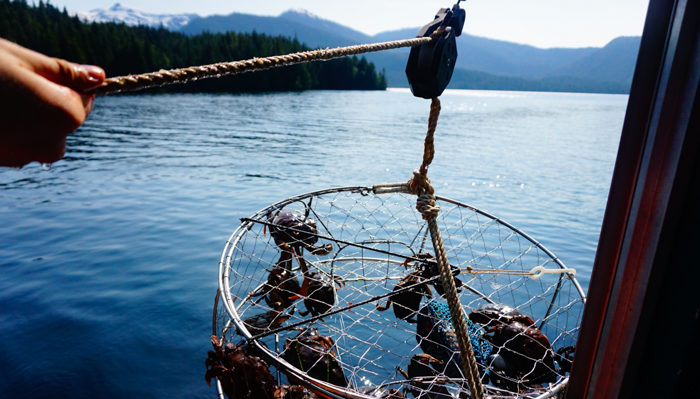
Guests line up to get a close-up view of crabs skittering around the pot. We even stroke their tummies before launching the pot back into the water. All that hard work has built up an appetite so thankfully we head back to shore for a gluttonous lunch.
George Inlet crab feast
The dining room of the George Inlet lodge hosts an array of tables covered in white paper tablecloths. We soon realise this is a highly practical move as a crab feast is messy business.
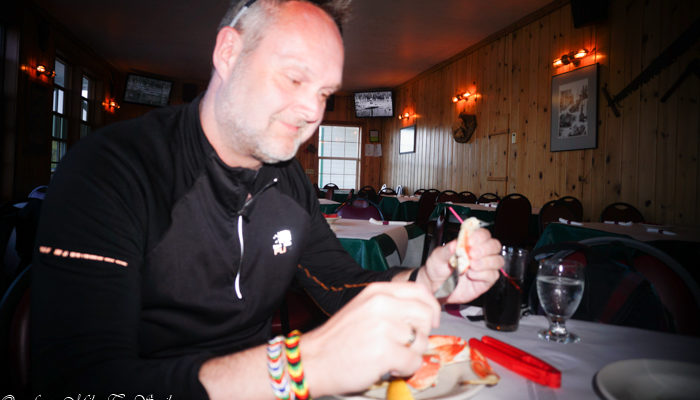
Our tour includes all you can eat crab and one complimentary drink. We opt for a ruby coloured craft beer and watch with anticipation as staff burst from the kitchen holding huge bowls of crab legs. They weave through the tables, depositing spindly limbs on plates and then hover to help the uninitiated extract the juicy flesh from the shell.
We listen murmurs of satisfied guests as they pluck sweet flesh from the shells and dunk them in small bowls of garlic butter. The tablecloth quickly litters as crab pieces take flight in the hands of inexperienced crab handlers. We soon can eat no more however and take to the dock to admire the scenery. Which brings me very nicely to the third reason you should put Ketchikan on your bucket list.
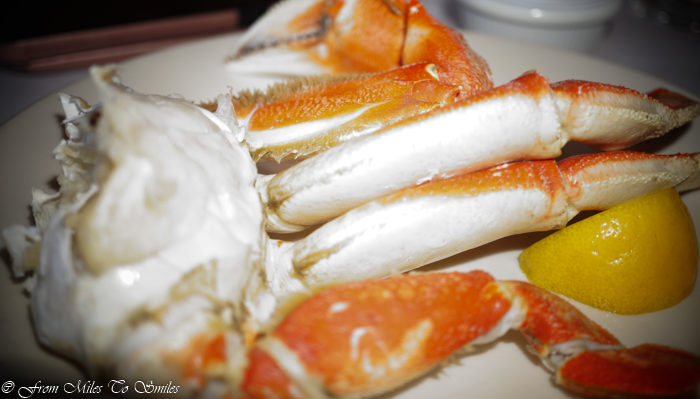
3. Glorious scenery
Ketchikan and surrounding areas are a spectacular feast for the eyes. Whether it’s the serenity of the inlets close to the city, the colourful boardwalks of downtown or the narrows on your approach, you need to ensure your camera is fully charged. If you cruise through the islands of the Alexander Archipelago, you will sail by snow covered mountains, pristine forest and the rugged shoreline of Revilla Island. The only hints of civilisation on your approach are those of ramshackle huts, dilapidated commercial buildings and logging outfits. Even they look pretty as a picture in their ruinous state.
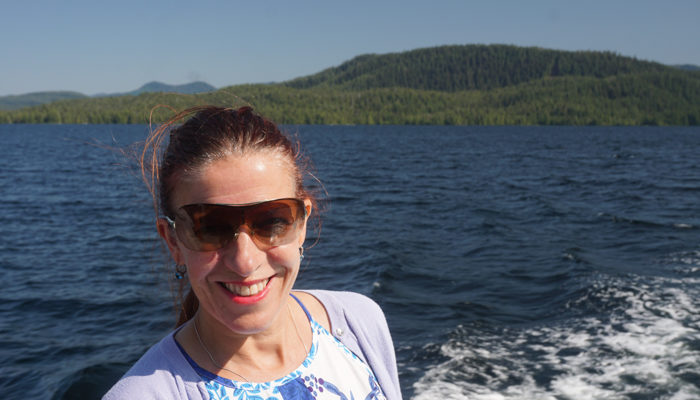
The town itself is a colourful jumble of boardwalks, tourist shops and restaurants. Vibrant trolley buses and duck tours ply the waterfront, showcasing the attractions of the city. I am however going to let the photos do the talking.
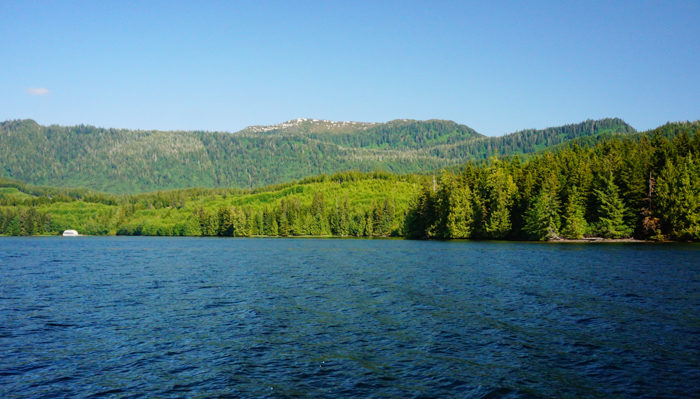
4. Outdoor activities
Just to stress, our time in Ketchikan was limited so we did not have time to participate in any activities hence why I want to return. You could easily spend three days or more in Ketchikan if you are not visiting on a cruise ship.
The range of options for those who love outdoor activities and adventure sports is endless. You can tear up the trails on an off road buggy, kayak around deserted inlets in search of wildlife or hike through glorious rainforest. To find the tour to suit your budget and travel style, check out the full range of tour options here. You certainly will not run out of things to do in the wickedest city in America.
5. Seductive history
Ketchikan inhabitants demonstrate a staunch ability to reinvent themselves. The city has undergone periods of boom in varied commercial activities from gold to salmon, bootlegging to prostitution and timber to tourism. This leaves behind a heritage of multi-coloured historical buildings scattered throughout the area. Visitors can travel back in time at several locations including the clapboard buildings of Creek Street and the Great Alaskan Lumberjack show.
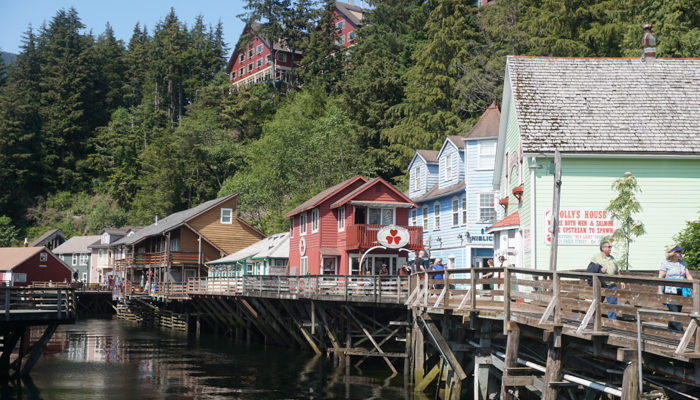
If you are a real history buff, visit the tourist information on the dock for more information or sign up for the Ketchikan pub crawl. Not only do you get the chance to sample some local brew on this tour, but you will discover the insalubrious history of Ketchikan. On this 90 minute walking tour, your guide recounts infamous stories from the prohibition era and the tour includes alcoholic beverages.
6. Charming downtown
The delights of downtown are a beacon to tourists who flood the town in a frenzied rush to explore. Here are just some of the highlights to prioritise if you are short on time which you can find on this map of downtown.

Salmon landing
The vibrant boardwalk that hugs the waters from the cruise terminal to the harbour is home to Salmon landing, a collection of tourist shops selling a vast array of items to tempt visitors. If you prefer to watch the world go by, this is a great place to find a bench, sit back and enjoy the bustle of activity around you.
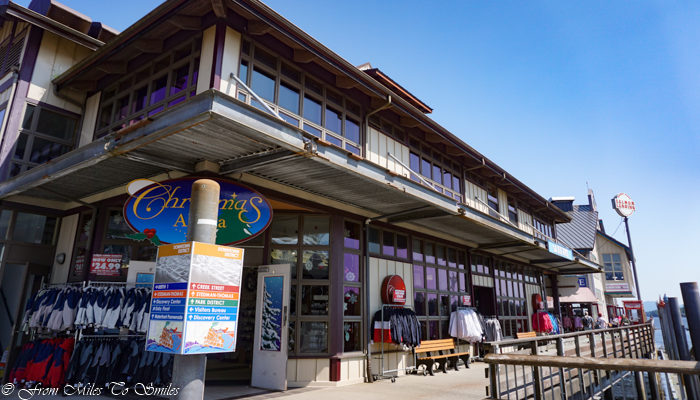
Creek Street
During prohibition, the lively boardwalk of Creek Street was the place to go for a boozy night out. Bootleggers smuggled Canadian whisky into numerous brothels and saloons along the creek taking advantage of the rising tide to make their deliveries. Goods were hauled in through hidden trapdoors in the floor of these buildings perched on stilts above the creek. It is hard to believe that over 30 brothels once lined this boardwalk, now an eclectic mix of quaint tourist shops and restaurants.
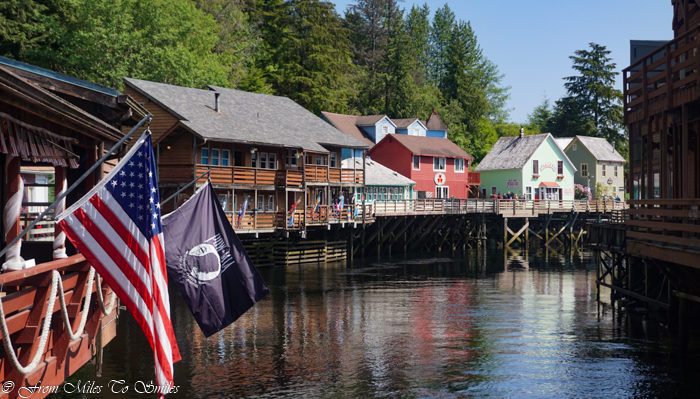
Totem poles
Ketchikan holds the record for the world’s largest collection of totem poles. It claims 180 totems in various sizes and designs and the Chief Johnson totem pole is particularly impressive (no 6 on the map). You can find out more about the pole on Ketchikan Stories.
Getting to Ketchikan
Surely by now you must be convinced that Ketchikan is not to be missed. This city truly offers something for everyone. From shoppers to nature lovers, wildlife enthusiasts and history buffs, Ketchikan packs a huge punch for such a small city. So, how do you get there?
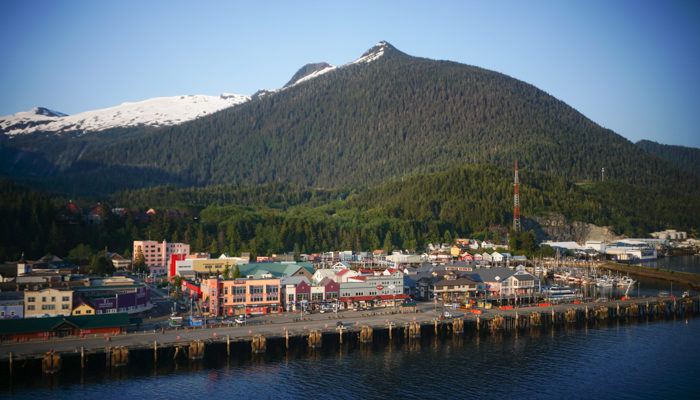
Plane
Alaska Airlines offers multiple flights a day to Ketchikan from Seattle and other cities in Alaska including Anchorage, Fairbanks, Juneau, Petersburg, Sitka, & Wrangell. Delta Airlines also operate flights to Ketchikan in summer. Flying into Ketchikan International Airport is quite the experience as it is located on nearby Gravina Island. Your transfer into town is via a quick 5-10 minute airport ferry rather than taxi or shuttle.
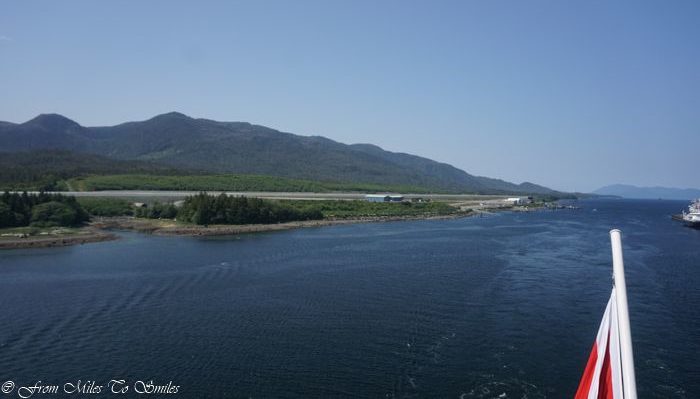
Sea
Ketchikan is a major port on the Inside Passage and you have two options if you wish to avoid flying.
Cruise ship
The first marine option is to book a cruise that includes Ketchikan on its itinerary. For most of the year Ketchikan is a sleepy place, yet for a few months in summer, cruise ships disgorge hordes of tourists who delight in the city’s attractions. We visited onboard Celebrity Eclipse and the full 7 day Hubbard Glacier cruise itinerary takes in Juneau, Icy Strait Point, the Hubbard Glacier and Ketchikan. Ships berth just minutes from historic downtown and you can be exploring cute western style buildings in no time.
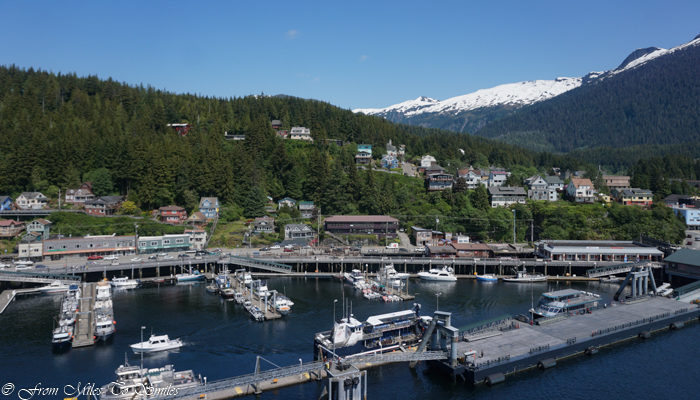
Alaska State Ferry
The other sea option is to jump on one of the ferries. The Alaska State Ferry travels between Bellingham, WA and Alaska, and there is an Inter-State Ferry that ferries passengers between Hollis on Prince of Wales Island and Ketchikan.
Car
Like many places in Alaska, Ketchikan is entirely inaccessible by road, other than on the ferry. Visitors must come by plane, ferry or cruise ship. Alaska is wild and remote for a reason, but that is what makes Alaska truly extraordinary.
Final thoughts
I cannot stress enough how much I love this colourful city. Whilst the city occupies a tiny sliver of land and has a population of around 8,000 people, it offers so much to those willing to make the effort to visit. My plan with Alaska was ‘once and done’ but after experiencing the delights of the Hubbard Glacier and Ketchikan, I am already planning my return. Except next time, it will be for longer and involve land stays. Go now before the world realises what it is missing.
 From Miles to Smiles Stylish travel for professionals seeking luxury at affordable prices
From Miles to Smiles Stylish travel for professionals seeking luxury at affordable prices
